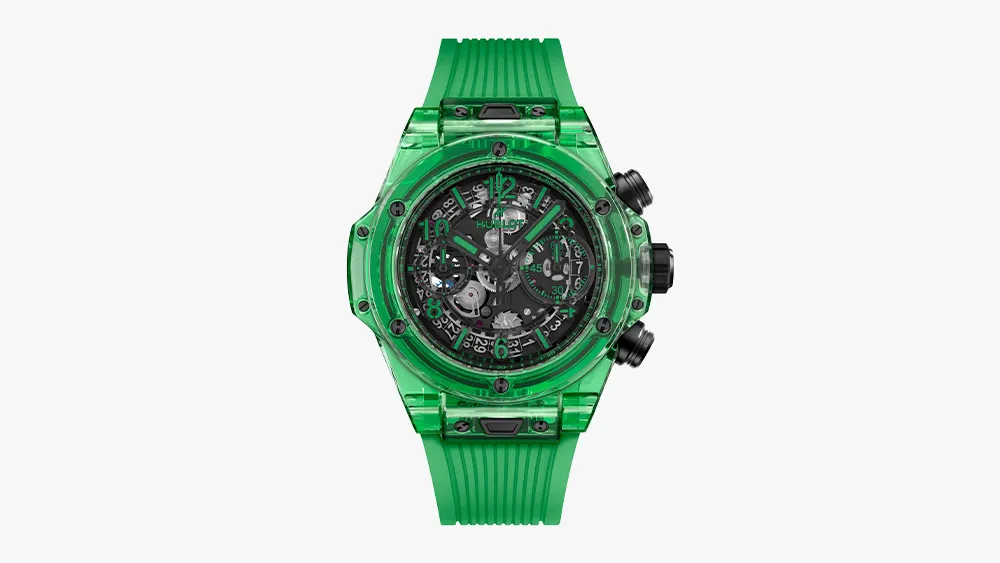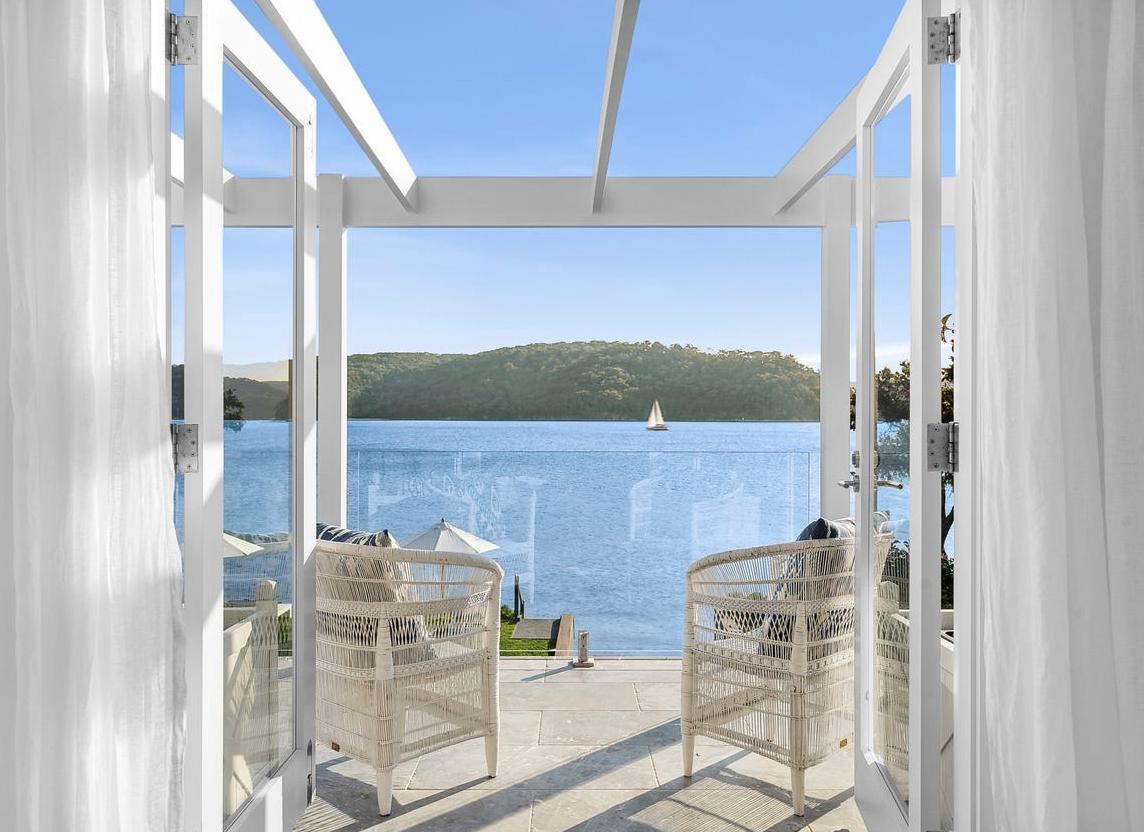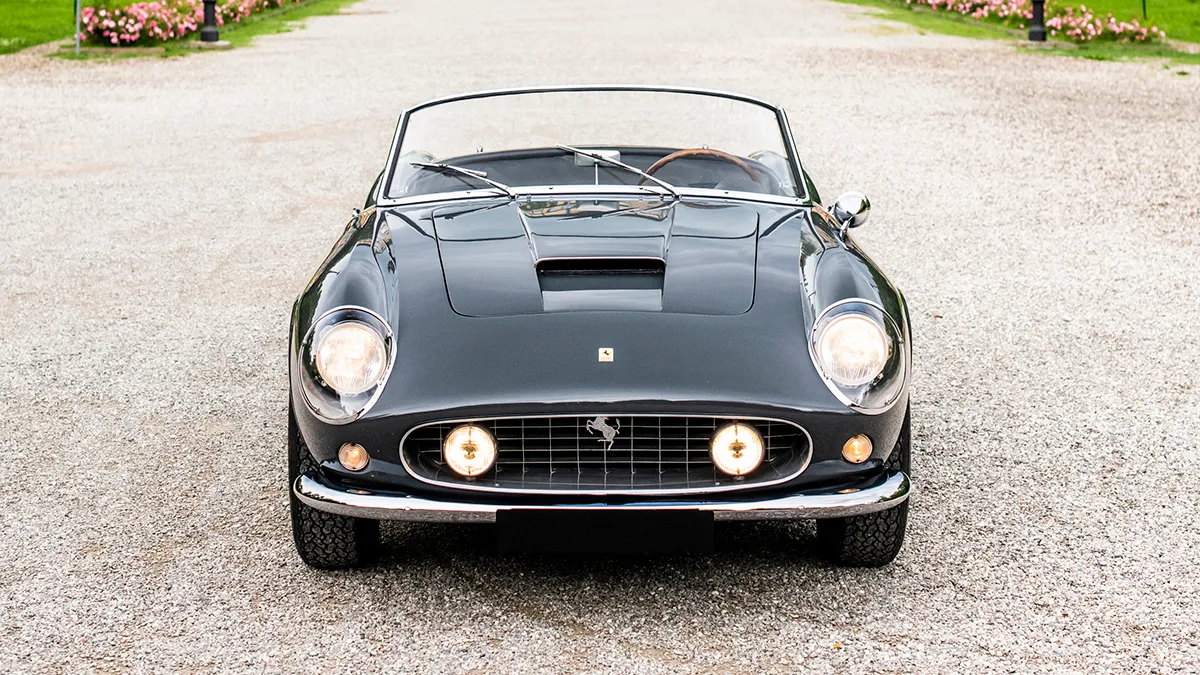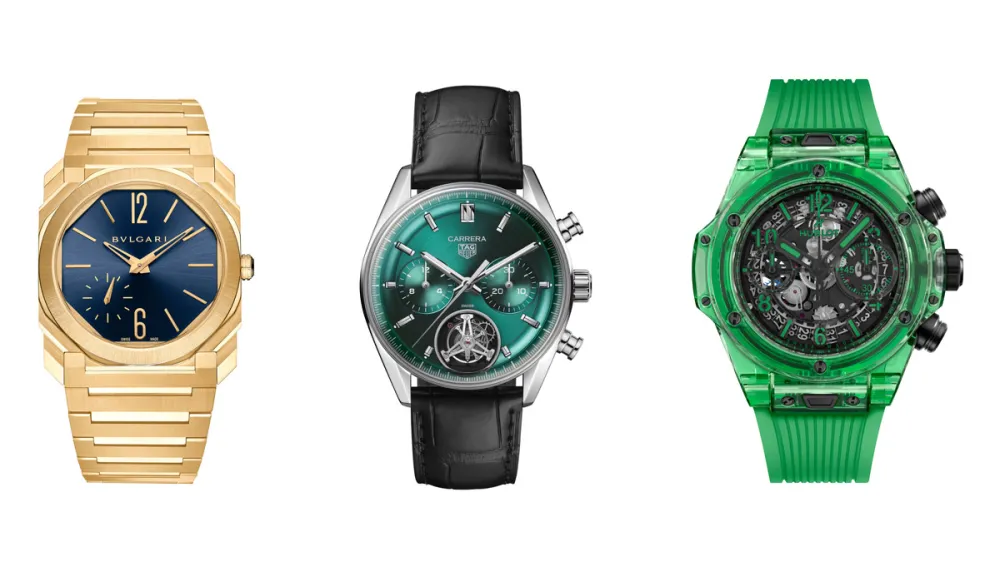
Bulgari, Hublot, and TAG Heuer Just Dropped Their New Watches for 2024
LVMH’s horological brands headed to Miami to introduced the year’s freshest models. Here’s a look at the best.
Related articles
LVMH Watch Week kicked off yesterday in Miami. The annual event, which began in 2019 in Dubai just ahead of the pandemic, has meant the luxury conglomerate is the first in the watch industry to launch new releases. It’s a wise and strategic move for the company to flex its timepieces in a major press moment, while the rest of the industry generally waits until Watches & Wonders in April in Geneva.
“The concept was actually founded by Bulgari, by [Jean] Christophe [Babin],” said Frédéric Arnault, the newly minted CEO of LVMH’s watch division, at a poolside cocktail event at the W Hotel. “Initially, it was to really kickstart the year. It started with three brands from LVMH: Bulgari, Hublot, and Zenith. I’m proud to say it grew over time from how successful it was. It’s a great moment for all of our watch brands. It shows the strength and ambition of the group, LVMH. It is such an important category in the luxury world.”
This year, the event included six brands under the watch division: Bulgari, Daniel Roth, Gérald Genta, Hublot, TAG Heuer, and Zenith. Notably absent were Louis Vuitton and Tiffany & Co., two of LVMH’s largest brands that carry watches. It’s no secret that watches are a big push at both, particularly Louis Vuitton, but rumor has it that they’ll join next year’s edition. As far as this year’s participants go, the releases were mostly subdued with tweaks to existing models in new dial colors or case materials, such as a new green Hublot Big Bang SAXEM or a new sunray blue dial for the 18-karat yellow gold Octo Finissimo. Others, like the Daniel Roth Tourbillon Souscription timepiece—a tour de force revival of the revered brand—had already been released to the press last year. Nevertheless, the week is more about drumming up a big press moment at the start of the year, ahead of every other watch conglomerate and brand in the industry. And, set against a backdrop of a white-pillared mansion on Miami’s ultra-exclusive Star Island overlooking the city’s turquoise waters glistening beneath the warm sun and 80 degrees in January, it certainly stands apart from the bustling stress of Watches & Wonders in chilly Geneva.
Hublot Big Bang Unico SAXEM Green
Hublot’s well-funded research and development division continues to make good on its commitment to find ways to add new colour to watchmaking’s most high-tech case materials, specifically ceramic and SAXEM, Hublot’s proprietary variation of sapphire crystal. Fans of the exuberantly colorful brand will remember last year’s launch of Sapphire Aluminum oXide and rare Earth Mineral, or SAXEM for short, in neon yellow. It’s a sapphire crystal-like substance that Hublot figured out how to infuse with a combination of minerals to create a fluorescent colour that glows like neon. This year it reappears in green, which is emerging as the year’s hottest color in watches. Like sapphire, SAXEM is transparent, so you can see the movement, the HUB1280 flyback chronograph, through the case side. For contrast, it is openworked and blackened, so the dial contrasts with the green case – calling to mind a popular look in jewellery design, the pairing of green garnet with blackened gold. The difference between sapphire and SAXEM, explains Hublot, is that Sapphire has a trigonal (three-sided) structure, while SAXEM has a cubic (four-sided) form.” Hence the more intense colour, like a gem with more facets. The material does not receive light, but creates the illusion of emitting it. It’s large size – 42mm – enhances the drama. SAXEM was first used in 2019 in a similar shade of emerald green on the Big Bang MP-11. An integrated rubber strap is perfectly matched to the case, as is the green lume on the hands. Hublot will make 100 pieces.
Price: Around$175,000, 100 pieces.
Case Material: SAXEM
Case Size: 42mm x 14.5mm
Hublot Classic Fusion Tourbillon Orlinski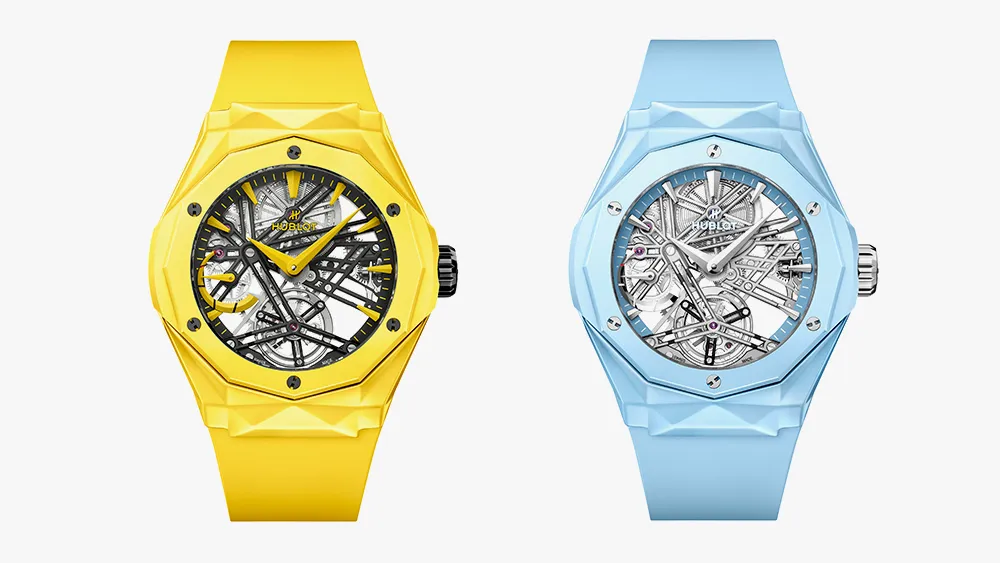
Hublot’s Classic Fusion Orlinski series has had a minimalist and muted aesthetic, with white or black dials and a slightly bolder royal blue ceramic version. This year it has been infused with a renewed sense of colour that doesn’t detract from the artist’s sculptural design so much as transform it. The design is stark and angular, with time only, plus seconds, leaving the faceted dial and bezel to deliver all the drama. This year the drama is in the colour. The Classic Fusion Tourbillon Orlinski appears in scorching-sun yellow or clear-sky blue versions, both infused in ceramic, inching them even closer to the dramatic pop art sculptures created by Hublot’s collaborator on the series, French artist Richard Orlinski. The architectural style of the watch carries over here to the openworked movement, the manually wound HUB6021 tourbillon, with faceted bridges coated in black PVD for the yellow version and silver rhodium for the blue version. There will be 30 pieces of each model.
Price: Around $143,000 pieces
Case Material: Ceramic
Case Size: 45mm x 10.6mm
Hublot MP-10 Tourbillon Weight Energy System Titaniu
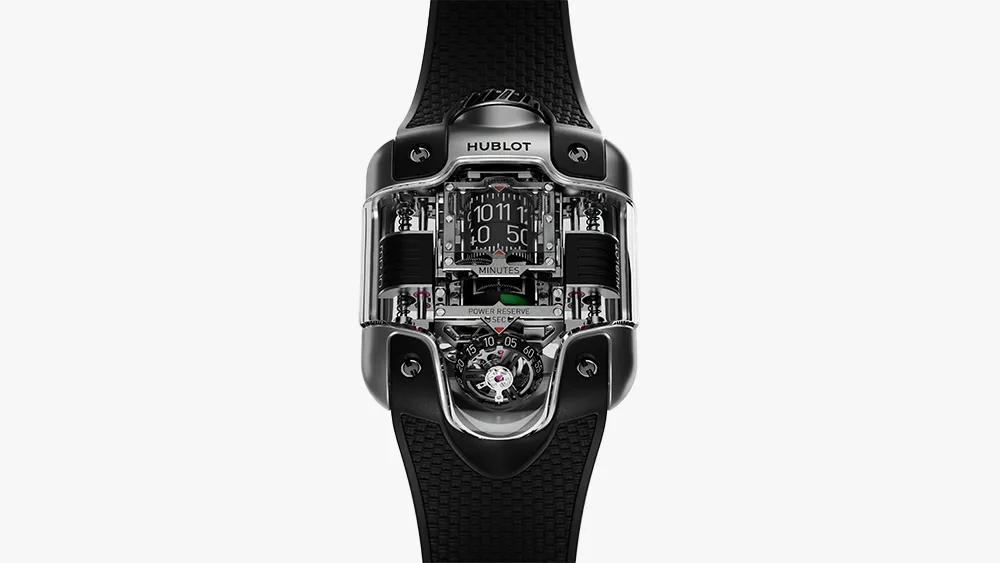
Hublot is a young brand, founded in 1980, compared to most top Swiss watch brands, which were founded about 100 years earlier. It therefore has a singular claim to post-modern watchmaking and design, free from the shackles of upholding the classical traditions of watchmaking. It has proposed instead to take watchmaking into the future. Its masterpiece line, or MP, thus has one goal: to reinvent existing complications. The MP-10, the brand’s tenth MP takes on the tourbillon. It has no dial, no hands and no oscillating weight (even though it’s automatic). The 592-component movement was five years in development and works on a system of aluminum rollers and a vertical winding system. Time is read from top to bottom on four constantly rotating displays: Hours on top, followed by minutes, a red/green power reserve disk, and lastly seconds, rotating on the 60-second tourbillon. The seconds take prominence over the tourbillon, since the escapement is angled at 35 degrees and thus largely out of sight. In case there is any misunderstanding about which functions are where, each is spelled out on bridges above or below each index. The case is made of two pieces – a middle and a back – in micro-blasted titanium, with a sapphire crystal wrapped on three inclined planes on three axes. Hublot has a patent pending for this configuration, its most complex to date. The rotor is not a rotor at all, since it doesn’t rotate. It works on a verticalised weight principle with two blocks of white gold that move up and down, winding the movement bidirectionally. Shock absorbers prevent them from colliding at each end. The system, which delivers 48 hours of power reserve, is also pending a patent pending. There are two crowns, neither of which rests in the traditional 3 o’clock position. The massive crown at 12 o’clock winds the watch. Time is set using a second crown nestled on the caseback side “to preserve the fluidity of the design,” explains the Hublot release.
Price: Around $400,000, 50 pieces
Case Material: Titanium
Case Size: 54.1mm x 41.5mm x 22.4mm
Hublot Spirit of Big Bang Jewellery
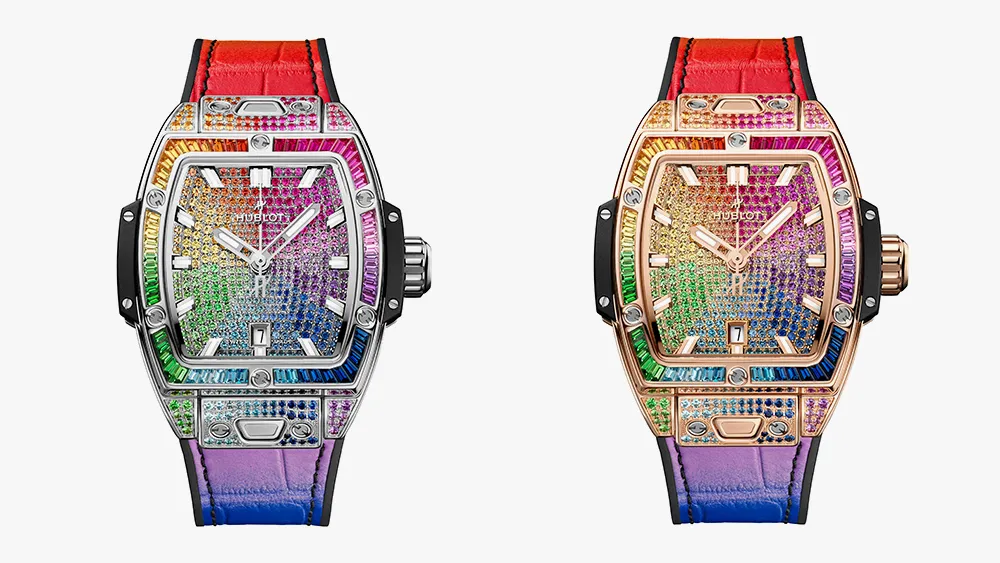
As a modern brand, Hublot has always had an uninhibited sense of the jewellery watch, more red-carpet bling than aristocratic classicism. This year’s Big Bang Jewelry collection includes a can’t-miss-it Rainbow model – the first of Hublot’s signature multi-colored sapphire pieces to appear in the barrel-cased Spirit of Big Bang collection. There are two versions, one in steel and the other in King Gold, Hublot’s proprietary warm red gold alloy. Each set with 493 multi-colored gems. Likewise, there are both steel and King Gold versions of the new Spirit of Big Bang Full Pavé showstoppers. Each is fully set with diamonds on the bezel, case, and dial, with a whopping 479 brilliant-cut gems totaling just over 2 carats. Hublot has even calculated the number of facets which adds up to: 27,782 per watch, with each of those facets reflecting light like a klieg light. They are accompanied by black or white rubber straps.
Prices:
Steel Full Pave: around $52,400
King Gold Full Pave: around $70,012
Steel Rainbow: around$110,200
King Gold Rainbow: $120,000
Case Material: King Gold, steel
Case Size: 32mm x 11.10mm
Bulgari Octo Finissimo
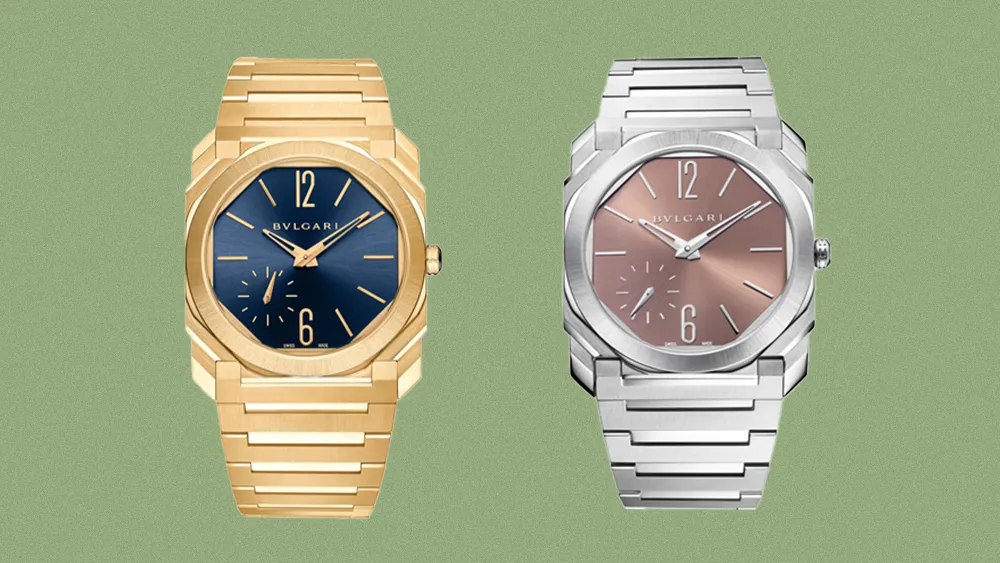
If these two models look familiar, that’s because they were officially launched in the U.S. market last year, but now Bulgari is announcing a global offering. The steel model with the Tuscan copper dial remains the same as the model that was initially released stateside last year in a limited run of 50. The 18-carat yellow gold model, however now comes dressed in a blue sunray dial. Its 2023 release in the U.S. came with a chocolate brown dial.There’s nothing groundbreaking here. This model has already done enough trailblazing—the Octo Finissimo has set eight world records. The steel model is the most appealing with the coolness of the metal paired with the soft warmth of copper, but while yellow gold might seem rather bold on a watch with such a wide bracelet it’s not as overpowering as you might assume in person. A female Bulgari representative who was wearing the piece on her wrist at LVMH Watch Week made a compelling case for the yellow gold version, while also proving that even at 40 mm, this watch’s ergonomics somehow make the sizing work even on smaller wrists.
Price: Around $68,912 in Yellow Gold and $20,143 in Steel
Case Material: 18-karat Yellow Gold or Steel
Case Size: 40 mm x 6.4 mm
Bulgari Lucea
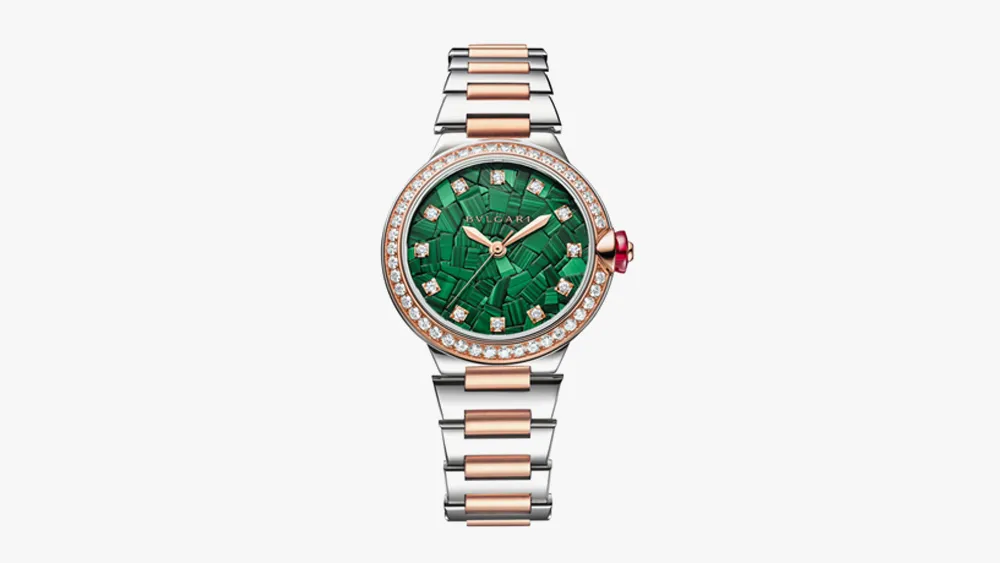
The Lucea collection is celebrating its 10th anniversary this year, so Bulgari naturally had to bring an ultra-special model to the table. The most striking new Lucea is the rich malachite dial version which was made with scraps of the stone material leftover from other watch models in the Bulgari manufacture. Instead of throwing away the tiny fragments, the company put them to use in a beautiful marquetry compilation. The varying hues of green create an arresting pattern accented by brilliant-cut diamond hour markers and encircled by a bezel adorned with 56 diamonds. The malachite pairs nicely with the two-tone case and bracelet in steel and 18-carat rose gold, as well as the ruby crystal crown protector. It is, by far, the most outstanding Lucea release of the year (so far).
Price: TBC
Case Material: Steel and 18-karat Rose Gold
Case Size: 33 mm x 9.6 mm
La Fabrique du Temps X Gérald Genta Manufacture Calibre GG-001
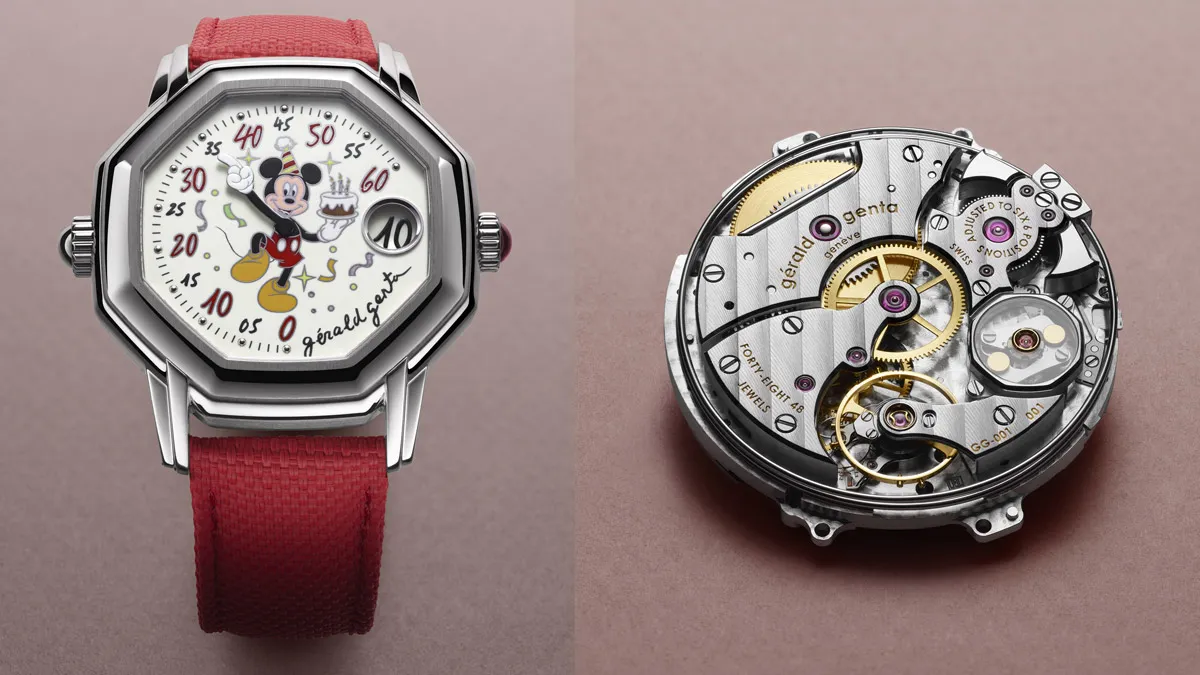
Forty years after famed watch designer Gérald Genta first defied the highly traditional watch industry by putting Mickey Mouse on a watch dial, La Fabrique du Temps is resurrecting this playful design as it relaunches the brand. And for those of you who scoff at the idea of a Disney-themed timepiece, kindly consider the type of watch we’re talking about: The new GG-001 is no simple time-only piece, but a minute repeater with a jump hour and retrograde minutes display developed by the horological illuminati at La Fabrique du Temps itself. Housed in a 32.4mm case that measures just 6.91mm thick, it has an impressive 80-hour power reserve and a beautiful dial graved by everyone’s favourite mouse: At 3 o’clock is a magnified jump-hour window, while Mickey’s left arm serves as the minute hand along a retrograde track running along the dial’s periphery. Playful yet subtle, this creative integration of multiple complications is an impressive feat of watchmaking — one that will be appreciated by both die-hard “watch nerds” and those whose taste runs more toward compelling aesthetics. (Not to mention by Disney fans everywhere!)
Price: TBD
Case Material: Platinum
Case Size: 40 mm
La Fabrique du Temps X Daniel Roth Tourbillon Souscription
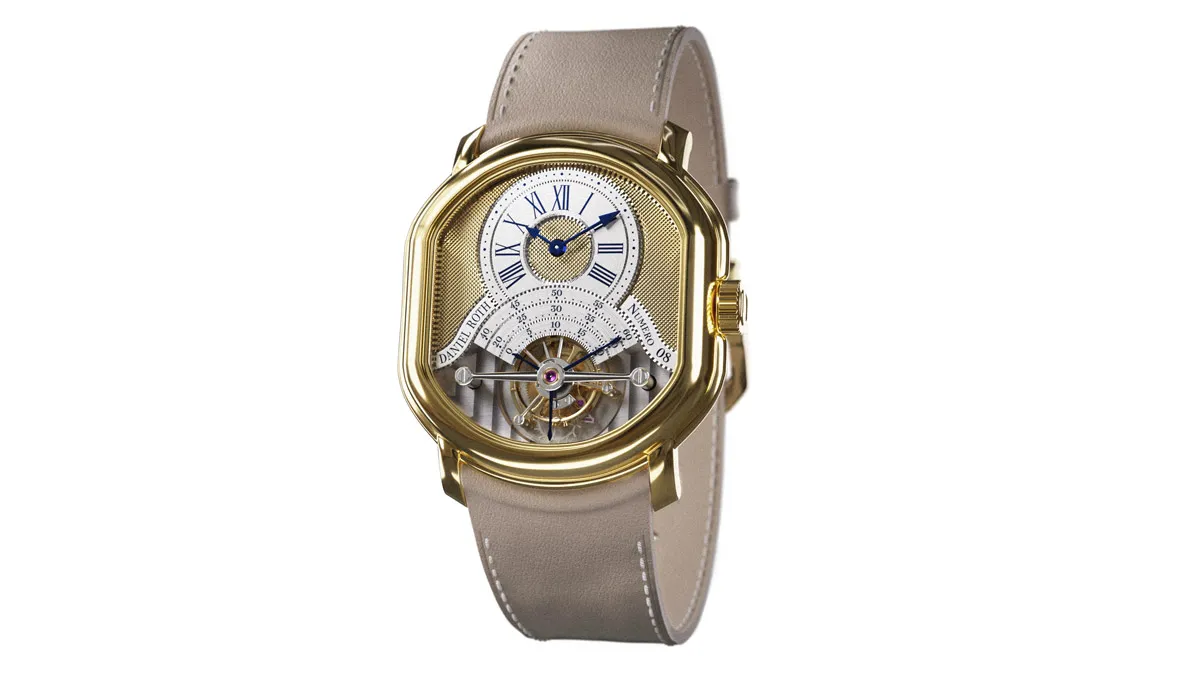
Since 2000, the Daniel Roth brand has been owned by Bulgari, which was itself acquired by LVMH in 2011. Now, the eponymous maison founded by the famed French-born watchmaker has been revived with the involvement of La Fabrique du Temps, the LVMH-owned movement manufacture founded by star horologists Michel Navas and Enrico Barbasini. The first product to see the light of day will certainly delight Daniel Roth fans: The new Tourbillon Souscription is an homage to the ref. 2187/C187, Roth’s first model. Housed in the watchmaker’s famed double-ellipse case, it takes inspiration from the designs of 18th/19th-century watchmaker Abraham-Louis Breguet, with exquisite finishing and the integration of remarkable complications. Extremely limited in production, the new timepiece features a solid-gold guilloché dial, a new in-house movement, and an impressively thin case depth of just 9.2mm. With its visible tourbillon cage and retrograde display, it’s truly a piece of horological art, and bodes well for the reconstitution of this important marque.
Price: TBD
Case Material: 18K yellow gold
Case Size: 38.6mm
TAG Heuer Plasma Diamant
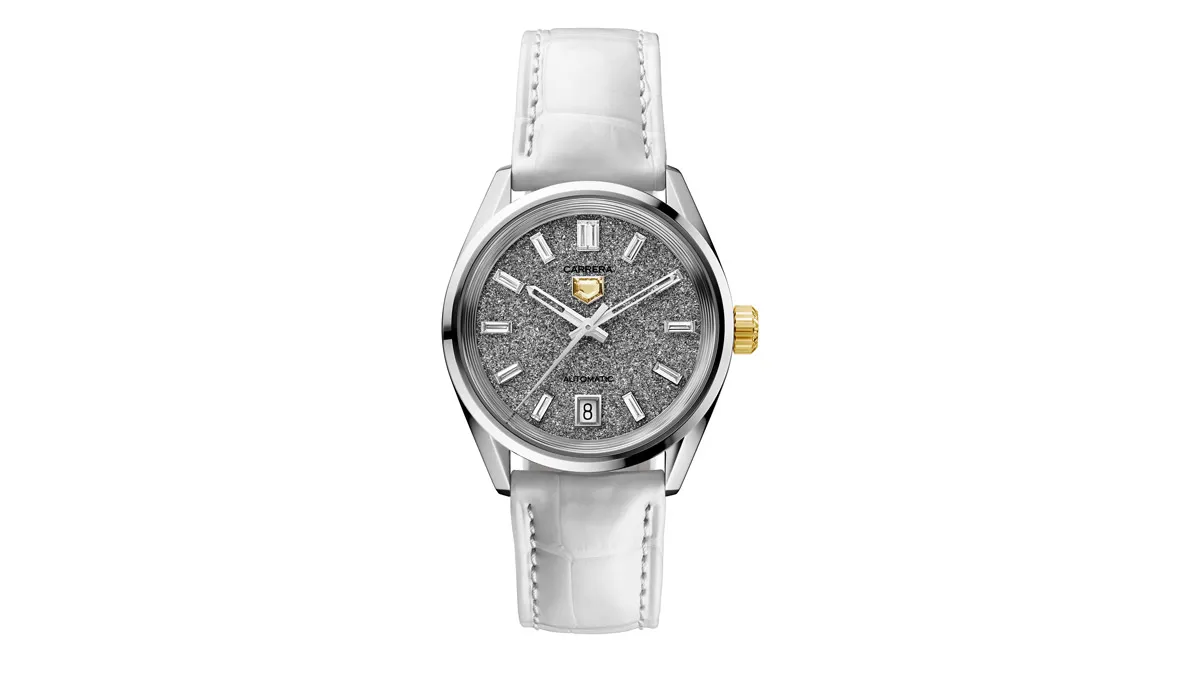
Just when you think the cutting edge of tool watch design means a tourbillon in your chronograph, TAG Heuer hits you with one of these: A sports watch positively encrusted in diamonds like the bottom of a caïque off the coast of Paros. The new TAG Heuer Carrera Date Plasma Diamant is merely the latest in a series of timepieces featuring lab-grown diamonds, whose uniform colour is achieved via a Chemical Vapor Deposition technology that the brand calls “Plasma.” In this instance, rather than set diamonds throughout the case of a larger 44mm watch such that of as last year’s Carrera Plasma Diamond d’Avant Garde, TAG Heuer has taken its 36mm, time-only version of the Carrera and jazzed it up: Fashioned from white gold, it features a 2.9-carat polycrystalline dial with baguette-cut diamond indices; a yellow gold TAG Heuer shield logo; and a 1.3-carat yellow diamond crown. The interplay between the case material, sparkling dial, and bright pops of yellow is striking without being gaudy — a difficult feat to achieve with this many precious stones.
Price: TBD
Case Material: White gold
Case Size: 36mm
TAG Heuer Carrera Chronograph Tourbillon
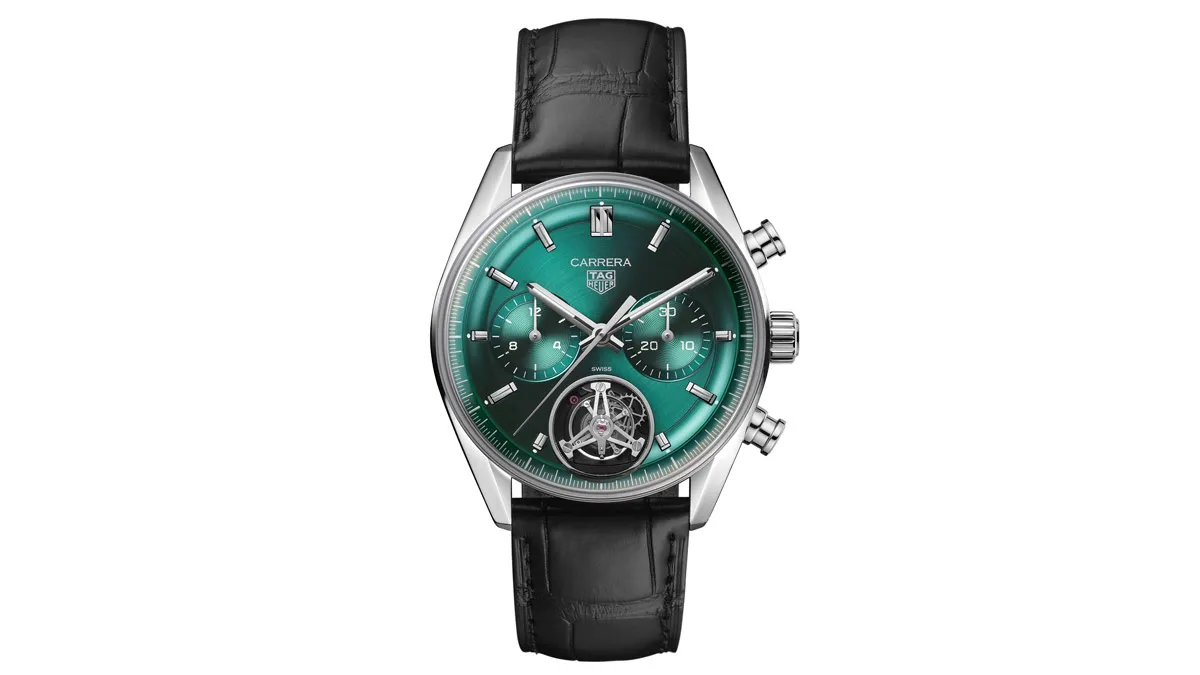
Launching alongside the aforementioned “Dato” model is a similarly teal-colored Carrera Chronograph in Tourbillon form, with a dual-register chronograph layout accompanied by Abraham-Louis Brguet’s famed invention visible at 6 o’clock. Developed by the famed French watchmaker in the early 19th century, the tourbillon is a horological device that places the movement’s escapement and balance wheel in a rotating cage, which helps negate the effects of gravity on a pocket watch movement. Nowadays, the inclusion of a tourbillon is a way for a watch company to show its expertise in movement construction, which TAG Heuer does here to good effect. Joined by 30-minute and 12-hour chronograph totalizers and easily visible beneath a curving “glassbox” sapphire crystal, the tourbillon in question is part of the TAG Heuer Calibre TH20-09 movement, which features bi-directional winding and a high level of finishing. Housed in a 42mm stainless steel “glassbox” Carrera case and paired to a black alligator leather strap, the TAG Heuer Carrera Chronograph Tourbillon is a high-end riff on a beloved sports watch.
Price: around $36,4300
Case Material: Stainless steel
Case Size: 42mm
TAG Heuer Carrera Chronograph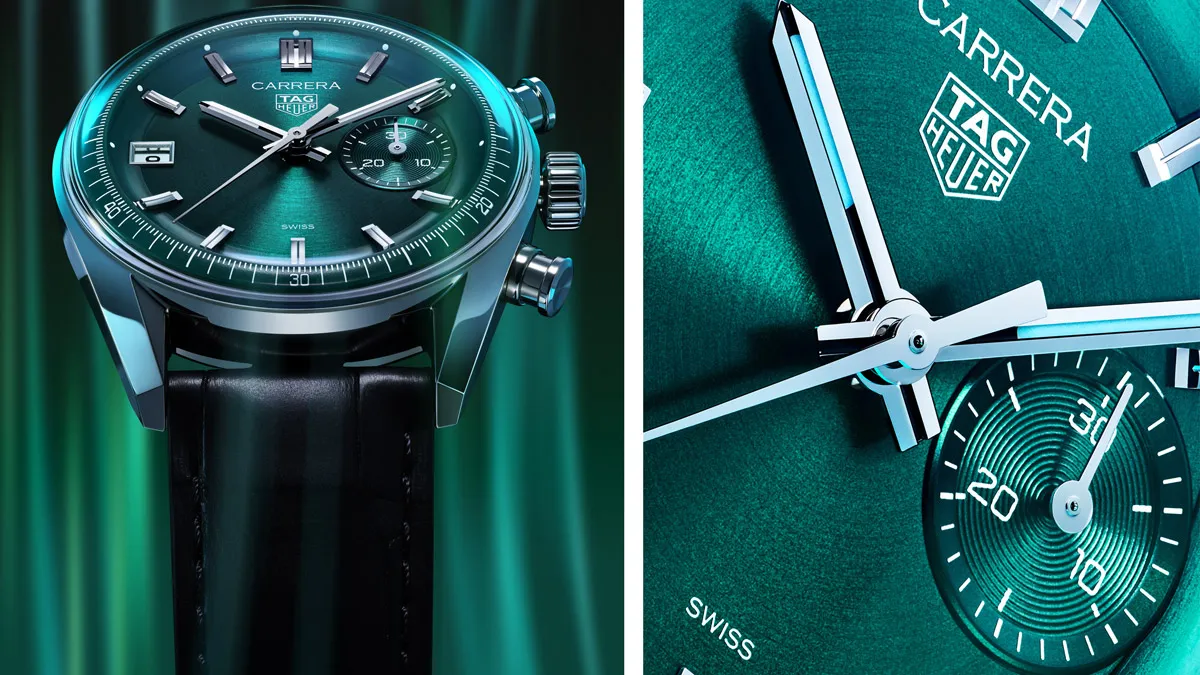
Jack Heuer, great-grandson of company founder Edouard Heuer, launched his famous racing chronograph in 1963, naming it after the Carrera Panamericana, a notoriously dangerous road race that took place in Mexico in the early 1950s. (And which also inspired the nickname of a certain Porsche.) Since then, the Carrera has taken on many guises, receiving a complete refresh in the form of the (still relatively new) “Glassbox” references launched in 2023 — just in time for the model’s 60th anniversary. This year, TAG Heuer is reviving a perennial fan favorite in the form of a new “Dato” model, which features a single, 30-minute chronograph totalizer at 9 o’clock and a date window at 9 o’clock. Hearkening back to a moderately rare Carrera variant from 1968, the new chrono marks the first time this unique date arrangement has appeared within the “Glassbox” case, which measures 39mm and features a curved inner flange housing a 1/5th-second track, all of which is enveloped by a gently curving “glassbox” crystal. With its striking, teal green dial and pared-down aesthetic, it’s sure to bridge the gap between fans of vintage Heuer and more casual watch buyers.
Price: Around $9,900
Case Material: Stainless steel
Case Size: 39mm
Zenith Chronomaster Original Triple Calendar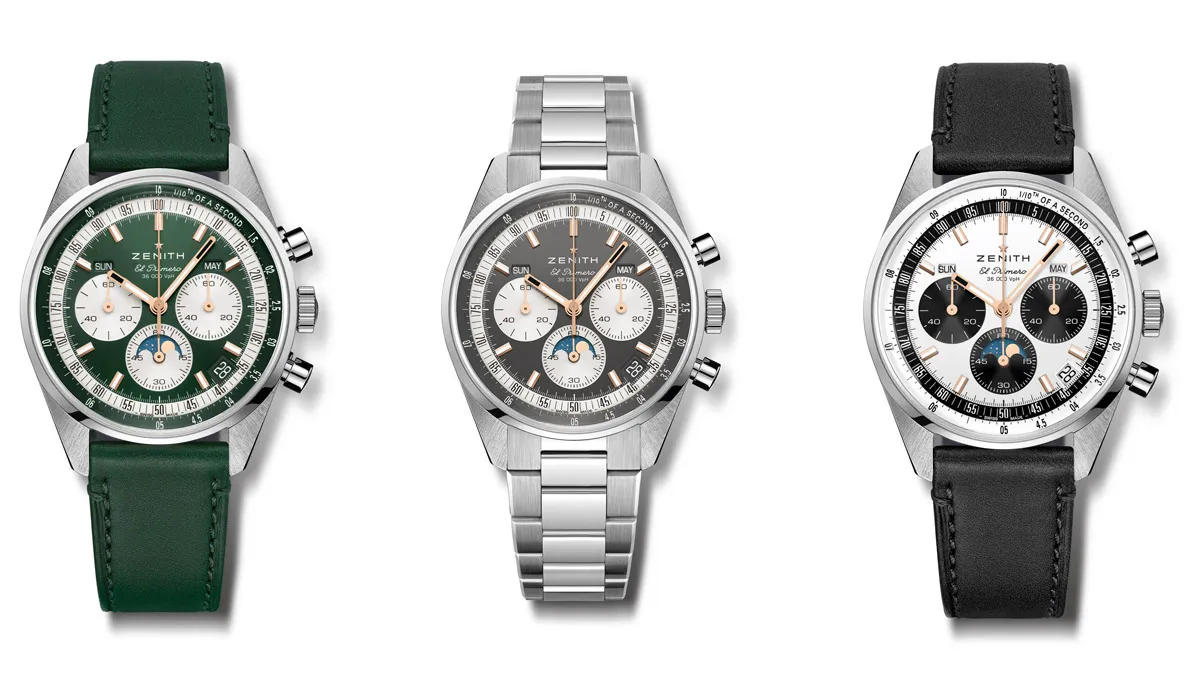
Most watch brands, when they announce the re-issue of a vintage design, are quick to include a note that while the design may be true to the original, the watch now contains a modern, in-house movement. In Zenith’s case, the movement was already there. The high-frequency El Primero calibre contained in the new Chronomaster Original Triple Calendar is a direct evolution of the one designed in 1969. In fact, the original El Primero movement was designed to accommodate triple calendar and moon phase functions right from the very beginning. Zenith made a small series of 25 prototypes in 1970 as a proof of concept, but since the chronograph was more popular, the triple calendar wasn’t produced commercially until later in the 1970s. The homage version is a tribute to the original movement, and its design is true to the signature A386 chronograph case design from 1969. The dial architecture mirrors the chronograph design codes – from a distance, you might have to do a second take to notice the Triple Calendar is not a chronograph-only. Days of the week and months are displayed in subtle windows above the east/west subdials – with small seconds at 9 o’clock and 60-second counter at 3 o’clock. The date window is in the traditional El Primero position at 4:30, and the moonphase display is incorporated right into the chronograph’s 60-minute counter at 6 o’clock. The El Primero 3610, runs at 36,000 vph to deliver a true 1/10th of a second chronograph function. Even with the addition of the complete calendar, it has a power reserve of approximately 60 hours. There are two regular versions, one with a sporty silvery-white panda opaline dial with black counters and 1/100th of a second scale, and an opaline slate-gray dial with silvery-white counters and scale that is directly inspired by the small series of El Primero triple calendar prototypes from 1970. A third, boutique-only variant has a sunburst olive-green dial. All have rose gold-tone applied baton markers and hands, to match the polished rose gold moon.
Prices: Around $21,055 for steel with metal bracelet (including boutique edition) and around $8,847 for steel with calfskin strap (including boutique edition)
Case Material: Stainless steel
Case Size: 38mm
Zenith Chronomaster Sport
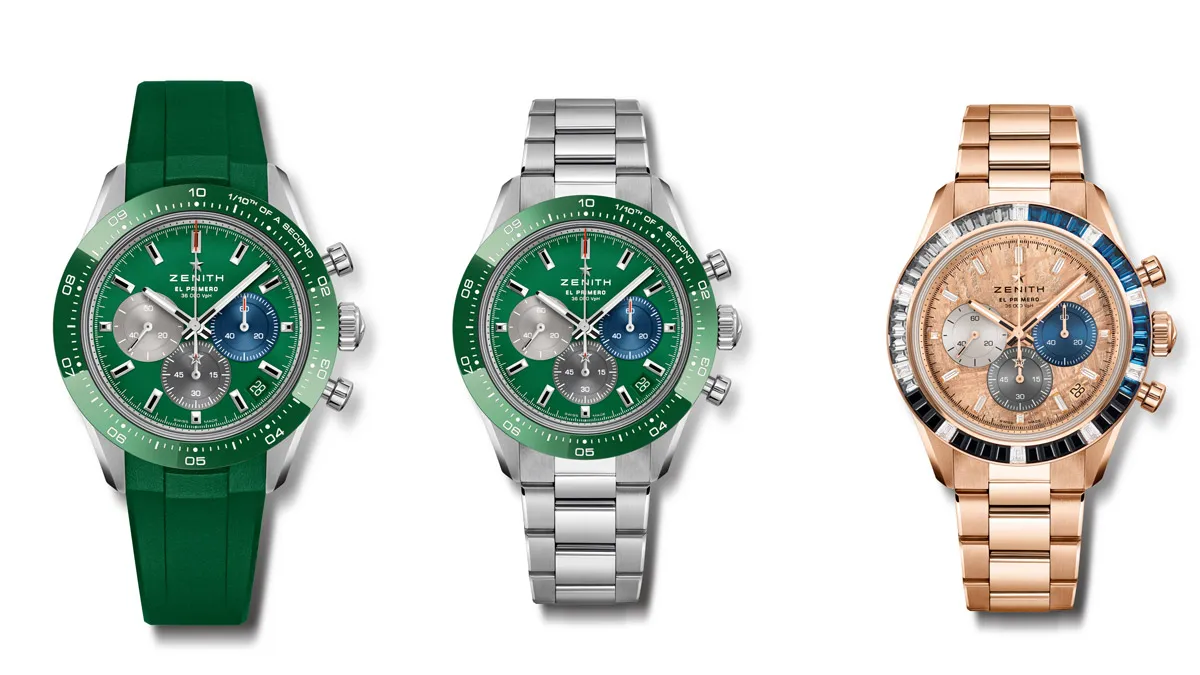
Having perfected the El Primero movement over the past 55 years, Zenith is now ready to have a little fun with the design of its flagship chronograph – but not so much that it obliterates the signature look. Two new versions include a first-ever gem-set Chronomaster Sport and an all-green model with a first-ever green ceramic bezel. Both models retain the signature tri-colour subdials of the Chronomaster in the familiar shades of gray and blue. The background dial of the green version is lacquered green to match the ceramic bezel and there’s a green FKM rubber strap to switch out the steel bracelet. The green is a vibrant, almost neon colour that is emerging as a strong watch colour, and it works surprisingly well with the tri-colour subdials. On the jewelled Chronomaster Sport, Zenith leans in even closer to the tri-colour aesthetic by setting the bezel with baguette-cut gems to match the subdials. There are white diamonds, black spinels (which read dark grey), and grey and blue sapphires. The dial is meteorite in the so-called “Windmanstätten” pattern (with long mineral crystals in geometric patterns), treated in a warm golden colour that matches the 18k rose gold case and bracelet. It’s a very dressy version of the Chronomaster Sport that dovetails with the ongoing trend toward dressing up sports watches and sporting up dress watches, which often cry out for definition: are sporty dress or dressy sport watches? The tri-colour chronograph registers, pump pushers, and El Primero 3600 movement tend to emphasise the sporty side of this one, but the precious gems and gold case elevate the watch to somewhere well beyond the race track. It’s your call.
Prices: Around $16,999 for Chronomaster Sport Green on bracelet; TBC for Chronomaster Sport Green on rubber strap and around $149,000for 18k rose gold Chronomaster Sport (boutique only)
Case Material: Chronomaster Sport Green, stainless steel; Chronomaster Sport 18-carat rose gold
Case Size: 41mm
Subscribe to the Newsletter
Recommended for you
Watches & Wonders 2024 Showcase: Hermès
We head to Geneva for the Watches & Wonders exhibition; a week-long horological blockbuster featuring the hottest new drops, and no shortage of hype.
By Josh Bozin
July 24, 2024
Watch This Space: Mike Nouveau
Meet the game-changing horological influencers blazing a trail across social media—and doing things their own way.
By Josh Bozin
July 22, 2024
You may also like.
By Josh Bozin
24/07/2024
You may also like.
5 Lounge Chairs That Add Chic Seating to Your Space
Daybeds, the most relaxed of seating solutions, offer a surprising amount of utility.
Chaise longue, daybed, recamier, duchesse brisée—elongated furniture designed for relaxing has a roster of fancy names. While the French royal court of Louis XIV brought such pieces to prominence in fashionable European homes, the general idea has been around far longer: The Egyptian pharaohs were big fans, while daybeds from China’s Ming dynasty spurred all those Hollywood Regency fretwork pieces that still populate Palm Beach living rooms. Even Mies van der Rohe, one of design’s modernist icons, got into the lounge game with his Barcelona couch, a study of line and form that holds up today.
But don’t get caught up in who invented them, or what to call them. Instead, consider their versatility: Backless models are ideal in front of large expanses of glass (imagine lazing on one with an ocean view) or at the foot of a bed, while more structured pieces can transform any corner into a cozy reading nook. Daybeds may be inextricably linked to relaxation, but from a design perspective, they put in serious work.

Emmy, Egg Collective
In designing the Emmy chaise, the Egg Collective trio of Stephanie Beamer, Crystal Ellis and Hillary Petrie, who met as students at Washington University in St. Louis, aimed for versatility. Indeed, the tailored chaise looks equally at home in a glass skyscraper as it does in a turn-of-the-century town house. Combining the elegance of a smooth, solid oak or walnut frame with the comfort of bolsters and cushioned upholstery or leather, it works just as well against a wall or at the heart of a room. From around $7,015; Eggcollective.com
 Plum, Michael Robbins
Plum, Michael Robbins
Woodworker Michael Robbins is the quintessential artisan from New York State’s Hudson Valley in that both his materials and methods pay homage to the area. In fact, he describes his style as “honest, playful, elegant and reflective of the aesthetic of the Hudson Valley surroundings”. Robbins crafts his furniture by hand but allows the wood he uses to help guide the look of a piece. (The studio offers eight standard finishes.) The Plum daybed, brought to life at Robbins’s workshop, exhibits his signature modern rusticity injected with a hint of whimsy thanks to the simplicity of its geometric forms. Around $4,275; MichaelRobbins.com

Kimani, Reda Amalou Design
French architect and designer Reda Amalou acknowledges the challenge of creating standout seating given the number of iconic 20th-century examples already in existence. Still, he persists—and prevails. The Kimani, a bent slash of a daybed in a limited edition of eight pieces, makes a forceful statement. Its leather cushion features a rolled headrest and rhythmic channel stitching reminiscent of that found on the seats of ’70s cars; visually, these elements anchor the slender silhouette atop a patinated bronze base with a sure-handed single line. The result: a seamless contour for the body. Around $33,530; RedaAmalou
Dune, Workshop/APD
From a firm known for crafting subtle but luxurious architecture and interiors, Workshop/APD’s debut furniture collection is on point. Among its offerings is the leather-wrapped Dune daybed. With classical and Art Deco influences, its cylindrical bolsters are a tactile celebration, and the peek of the curved satin-brass base makes for a sensual surprise. Associate principal Andrew Kline notes that the daybed adeptly bridges two seating areas in a roomy living space or can sit, bench-style, at the foot of a bed. From $13,040; Workshop/ APD
Sherazade, Edra
Designed by Francesco Binfaré, this sculptural, minimalist daybed—inspired by the rugs used by Eastern civilizations—allows for complete relaxation. Strength combined with comfort is the name of the game here. The Sherazade’s structure is made from light but sturdy honeycomb wood, while next-gen Gellyfoam and synthetic wadding aid repose. True to Edra’s amorphous design codes, it can switch configurations depending on the user’s mood or needs; for example, the accompanying extra pillows—one rectangular and one cylinder shaped— interchange to become armrests or backrests. From $32,900; Edra
You may also like.
By Josh Bozin
24/07/2024
22/07/2024
Watches & Wonders 2024 Showcase: Hermès
We head to Geneva for the Watches & Wonders exhibition; a week-long horological blockbuster featuring the hottest new drops, and no shortage of hype.
With Watches & Wonders 2024 well and truly behind us, we review some of the novelties Hermès presented at this year’s event.
—
HERMÈS

Moving away from the block colours and sporty aesthetic that has defined Hermès watches in recent years, the biggest news from the French luxury goods company at Watches & Wonders came with the unveiling of its newest collection, the Hermès Cut.
It flaunts a round bezel, but the case middle is nearer to a tonneau shape—a relatively simple design that, despite attracting flak from some watch aficionados, works. While marketed as a “women’s watch”, the Cut has universal appeal thanks to its elegant package and proportions. It moves away from the Maison’s penchant for a style-first product; it’s a watch that tells the time, not a fashion accessory with the ability to tell the time.
Hermès gets the proportions just right thanks to a satin-brushed and polished 36 mm case, PVD-treated Arabic numerals, and clean-cut edges that further accentuate its character. One of the key design elements is the positioning of the crown, boldly sitting at half-past one and embellished with a lacquered or engraved “H”, clearly stamping its originality. The watch is powered by a Hermès Manufacture movement H1912, revealed through its sapphire crystal caseback. In addition to its seamlessly integrated and easy-wearing metal bracelet, the Cut also comes with the option for a range of coloured rubber straps. Together with its clever interchangeable system, it’s a cinch to swap out its look.
It will be interesting to see how the Hermès Cut fares in coming months, particularly as it tries to establish its own identity separate from the more aggressive, but widely popular, Ho8 collection. Either way, the company is now a serious part of the dialogue around the concept of time.
—
Read more about this year’s Watches & Wonders exhibition at robbreport.com.au
You may also like.
22/07/2024
Living La Vida Lagerfeld
The world remembers him for fashion. But as a new tome reveals, the iconoclastic designer is defined as much by extravagant, often fantastical, homes as he is clothes.
“Lives, like novels, are made up of chapters”, the world-renowned bibliophile, Karl Lagerfeld, once observed.
Were a psychological-style novel ever to be written about Karl Lagerfeld’s life, it would no doubt give less narrative weight to the story of his reinvigoration of staid fashion houses like Chloe, Fendi and Chanel than to the underpinning leitmotif of the designer’s constant reinvention of himself.
In a lifetime spanning two centuries, Lagerfeld made and dropped an ever-changing parade of close friends, muses, collaborators and ambiguous lovers, as easily as he changed his clothes, his furniture… even his body. Each chapter of this book would be set against the backdrop of one of his series of apartments, houses and villas, whose often wildly divergent but always ultra-luxurious décor reflected the ever-evolving personas of this compulsively public but ultimately enigmatic man.
With the publication of Karl Lagerfeld: A Life in Houses these wildly disparate but always exquisite interiors are presented for the first time together as a chronological body of work. The book indeed serves as a kind of visual novel, documenting the domestic dreamscapes in which the iconic designer played out his many lives, while also making a strong case that Lagerfeld’s impact on contemporary interior design is just as important, if not more so, than his influence on fashion.
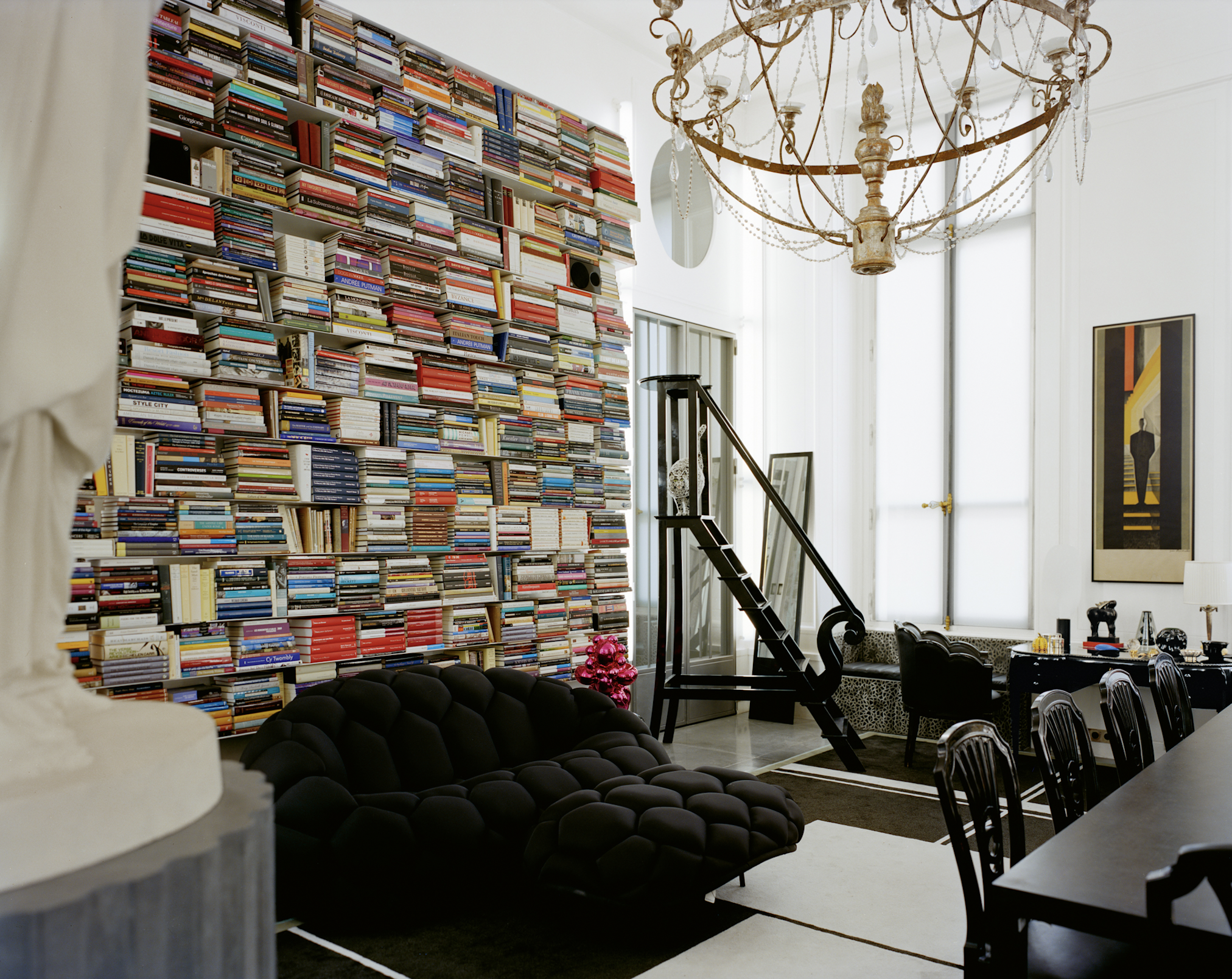
In fact, when the first Lagerfeld interior was featured in a 1968 spread for L’OEil magazine, the editorial describes him merely as a “stylist”. The photographs of the apartment in an 18th-century mansion on rue de Université, show walls lined with plum-coloured rice paper, or lacquered deepest chocolate brown in sharp contrast to crisp, white low ceilings that accentuated the horizontality that was fashionable among the extremely fashionable at the time. Yet amid this setting of aggressively au courant modernism, the anachronistic pops of Art Nouveau and Art Deco objects foreshadow the young Karl’s innate gift for creating strikingly original environments whose harmony is achieved through the deft interplay of contrasting styles and contexts.
Lagerfeld learned early on that presenting himself in a succession of gem-like domestic settings was good for crafting his image. But Lagerfeld’s houses not only provided him with publicity, they also gave him an excuse to indulge in his greatest passion. Shopping!
By 1973, Lagerfeld was living in a new apartment at Place Saint–Sulpice where his acquisition of important Art Deco treasures continued unabated. Now a bearded and muscular disco dandy, he could most often be found in the louche company of the models, starlets and assorted hedonistic beauties that gathered around the flamboyant fashion illustrator Antonio Lopez. Lagerfeld was also in the throes of a hopeless love affair with Jacques de Bascher whose favours he reluctantly shared with his nemesis Yves Saint Laurent.
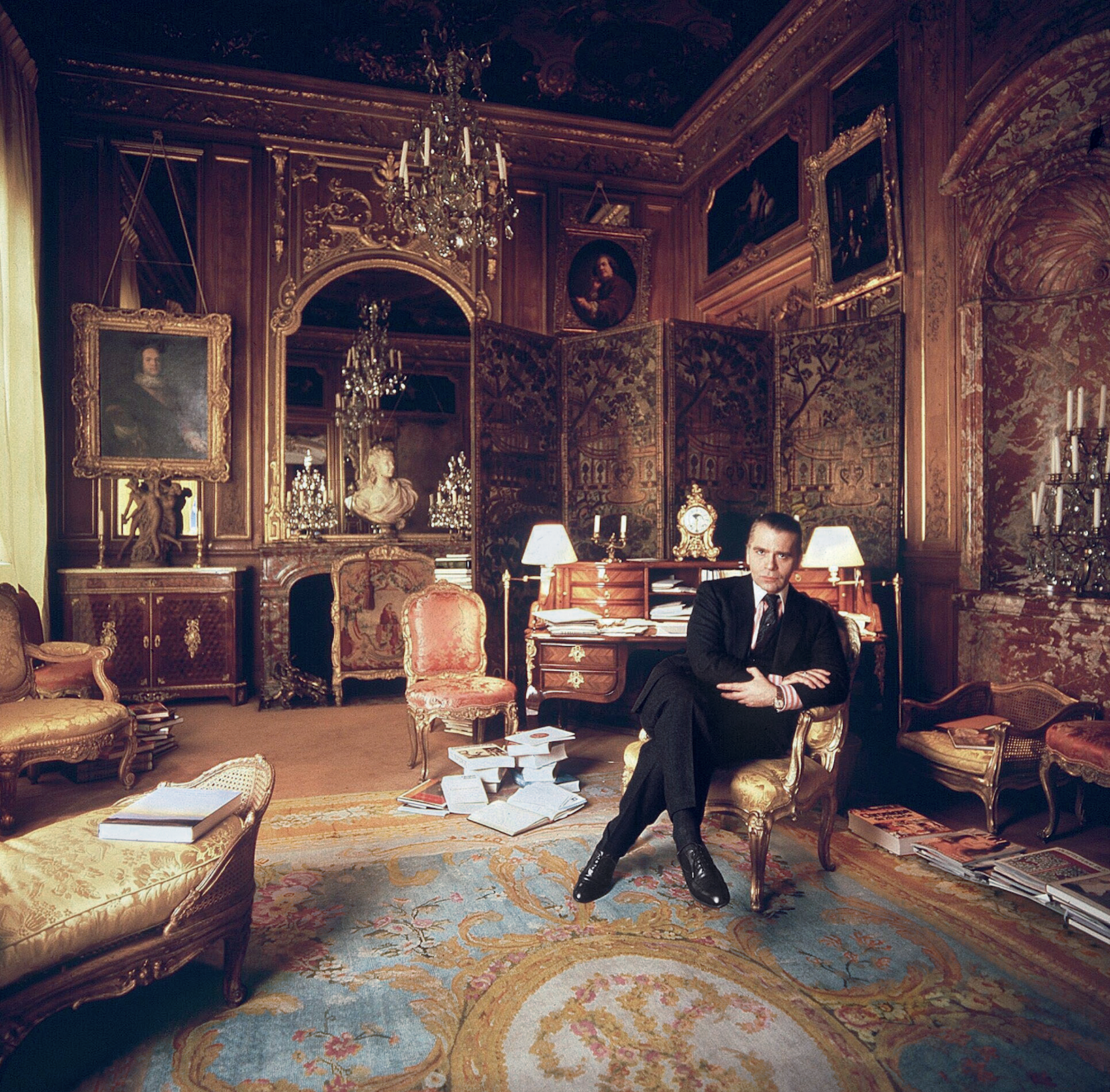
He painted the rooms milky white and lined them with specially commissioned carpets—the tawny patterned striations of which invoked musky wild animal pelts. These lent a stark relief to the sleek, machine-age chrome lines of his Deco furnishings. To contemporary eyes it remains a strikingly original arrangement that subtly conveys the tensions at play in Lagerfeld’s own life: the cocaine fuelled orgies of his lover and friends, hosted in the pristine home of a man who claimed that “a bed is for one person”.
In 1975, a painful falling out with his beloved Jacques, who was descending into the abyss of addiction, saw almost his entire collection of peerless Art Deco furniture, paintings and objects put under the auctioneer’s hammer. This was the first of many auction sales, as he habitually shed the contents of his houses along with whatever incarnation of himself had lived there. Lagerfeld was dispassionate about parting with these precious goods. “It’s collecting that’s fun, not owning,” he said. And the reality for a collector on such a Renaissance scale, is that to continue buying, Lagerfeld had to sell.
Of all his residences, it was the 1977 purchase of Hôtel Pozzo di Borgo, a grand and beautifully preserved 18th-century house, that would finally allow him to fulfill his childhood fantasies of life in the court of Madame de Pompadour. And it was in this aura of Rococó splendour that the fashion designer began to affect, along with his tailored three-piece suits, a courtier’s ponytailed and powdered coif and a coquettish antique fan: marking the beginning of his transformation into a living, breathing global brand that even those with little interest in fashion would immediately recognise.
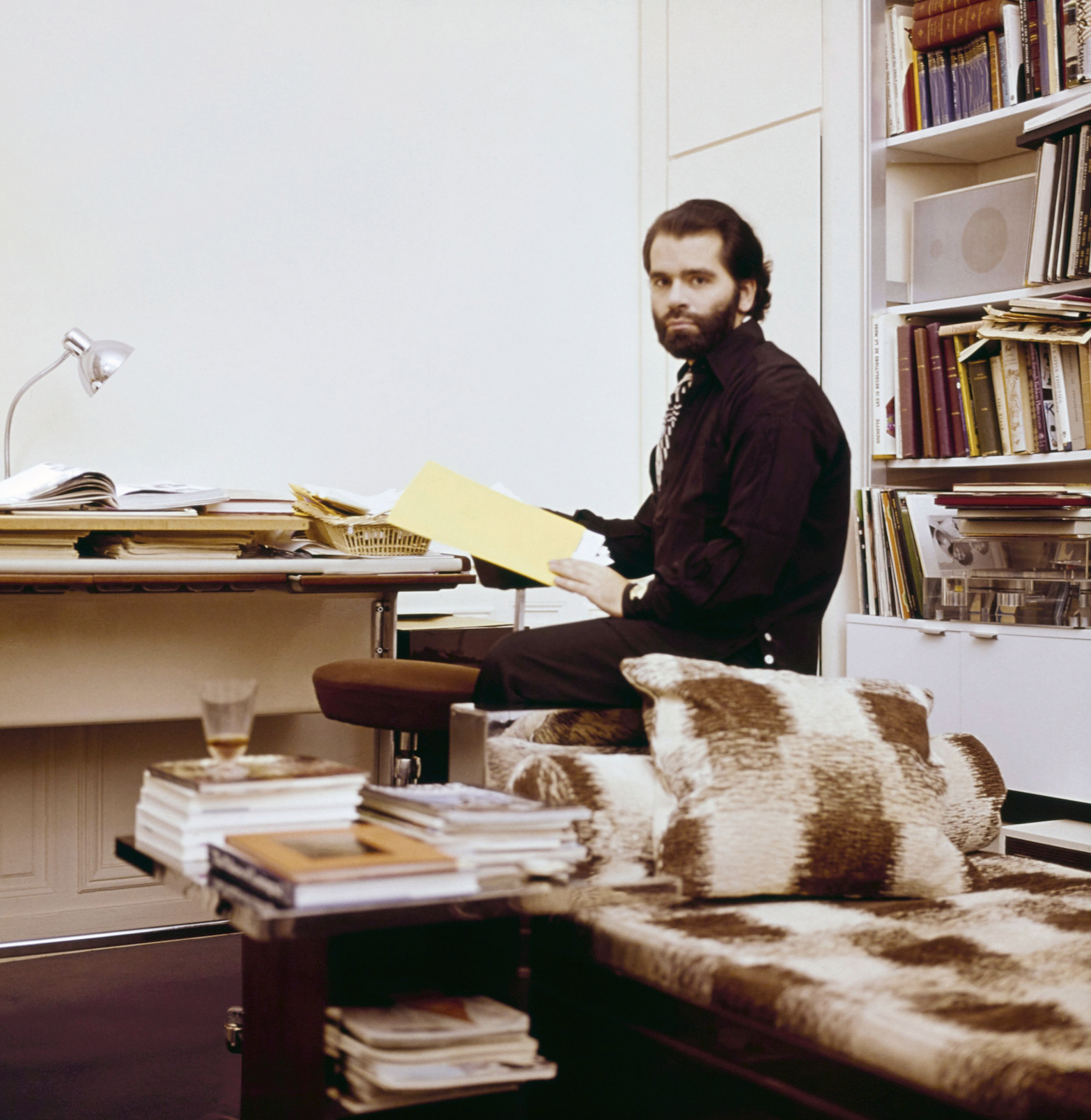
Lagerfeld’s increasing fame and financial success allowed him to indulge in an unprecedented spending frenzy, competing with deep-pocketed institutions like the Louvre to acquire the finest, most pedigreed pearls of the era—voluptuously carved and gilded bergères; ormolu chests; and fleshy, pastel-tinged Fragonard idylls—to adorn his urban palace. His one-time friend André Leon Talley described him in a contemporary article as suffering from “Versailles complex”.
However, in mid-1981, and in response to the election of left-wing president, François Mitterrand, Lagerfeld, with the assistance of his close friend Princess Caroline, became a resident of the tax haven of Monaco. He purchased two apartments on the 21st floor of Le Roccabella, a luxury residential block designed by Gio Ponti. One, in which he kept Jacques de Bascher, with whom he was now reconciled, was decorated in the strict, monochromatic Viennese Secessionist style that had long underpinned his aesthetic vocabulary; the other space, though, was something else entirely, cementing his notoriety as an iconoclastic tastemaker.
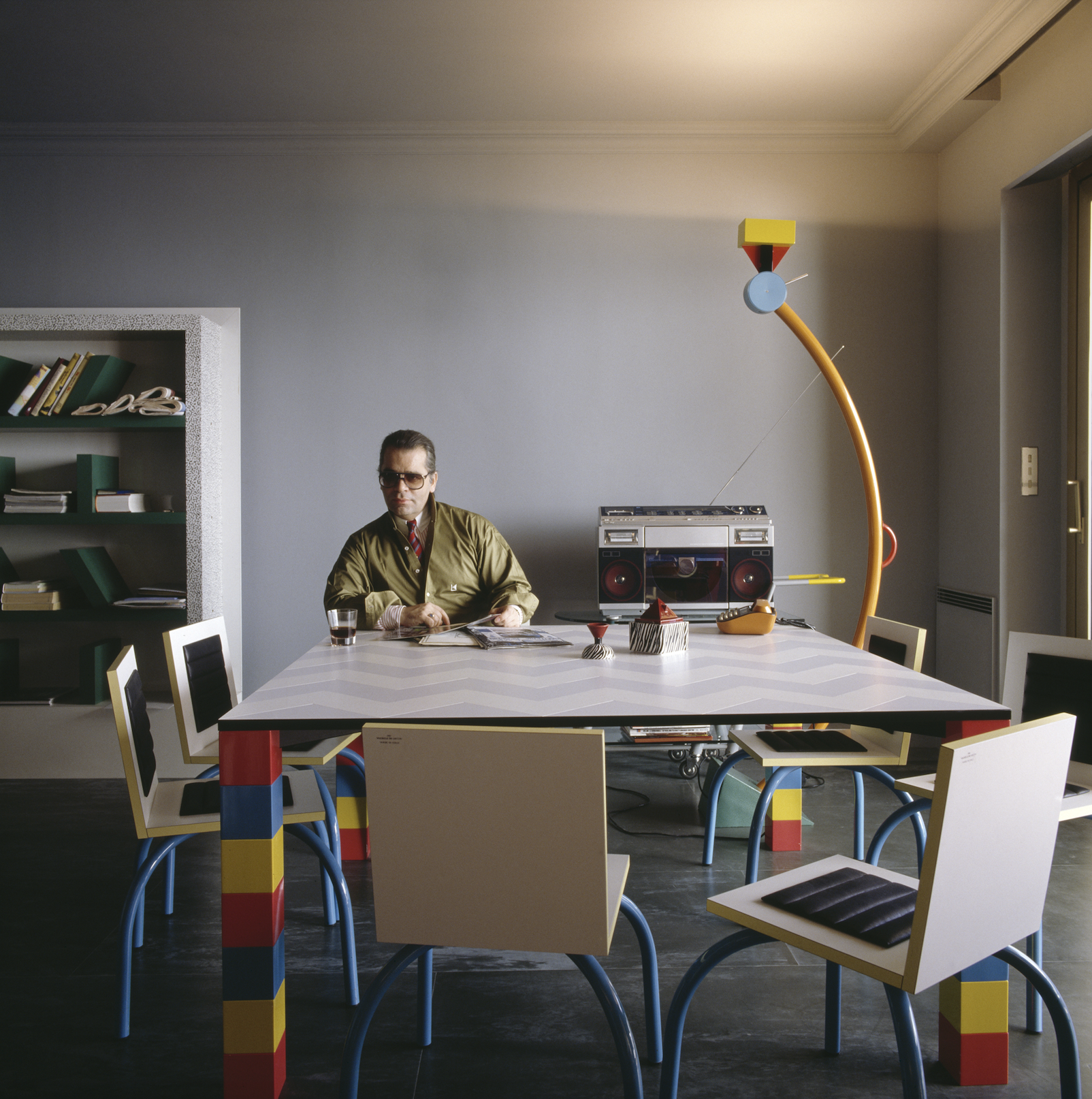
Lagerfeld had recently discovered the radically quirky designs of the Memphis Group led by Ettore Sottsass, and bought the collective’s entire first collection and had it shipped to Monaco. In a space with no right angles, these chaotically colourful, geometrically askew pieces—centred on Masanori Umeda’s famous boxing ring—gave visitors the disorientating sensation of having entered a corporeal comic strip. By 1991, the novelty of this jarring postmodern playhouse had inevitably worn thin and once again he sent it all to auction, later telling a journalist that “after a few years it was like living in an old Courrèges. Ha!”

In 1989, de Bascher died of an AIDS-related illness, and while Lagerfeld’s career continued to flourish, emotionally the famously stoic designer was struggling. In 2000, a somewhat corpulent Lagerfeld officially ended his “let them eat cake” years at the Hôtel Pozzo di Borgo, selling its sumptuous antique fittings in a massive headline auction that stretched over three days. As always there were other houses, but now with his longtime companion dead, and his celebrity metastasising making him a target for the paparazzi, he began to look less for exhibition spaces and more for private sanctuaries where he could pursue his endless, often lonely, work.
His next significant house was Villa Jako, named for his lost companion and built in the 1920s in a nouveau riche area of Hamburg close to where he grew up. Lagerfeld shot the advertising campaign for Lagerfeld Jako there—a fragrance created in memorial to de Bascher. The house featured a collection of mainly Scandinavian antiques, marking the aesthetic cusp between Art Nouveau and Art Deco. One of its rooms Lagerfeld decorated based on his remembrances of his childhood nursery. Here, he locked himself away to work—tellingly—on a series of illustrations for the fairy tale, The Emperor’s New Clothes. Villa Jako was a house of deep nostalgia and mourning.
But there were more acts—and more houses—to come in Lagerfeld’s life yet. In November 2000, upon seeing the attenuated tailoring of Hedi Slimane, then head of menswear at Christian Dior, the 135 kg Lagerfeld embarked on a strict dietary regime. Over the next 13 months, he melted into a shadow of his former self. It is this incarnation of Lagerfeld—high white starched collars; Slimane’s skintight suits, and fingerless leather gloves revealing hands bedecked with heavy silver rings—that is immediately recognisable some five years after his death.
The 200-year-old apartment in Quái Voltaire, Paris, was purchased in 2006, and after years of slumber Lagerfeld—a newly awakened Hip Van Winkle—was ready to remake it into his last modernist masterpiece. He designed a unique daylight simulation system that meant the monochromatic space was completely without shadows—and without memory. The walls were frosted and smoked glass, the floors concrete and silicone; and any hint of texture was banned with only shiny, sleek pieces by Marc Newson, Martin Szekely and the Bouroullec Brothers permitted. Few guests were allowed into this monastic environment where Lagerfeld worked, drank endless cans of Diet Coke and communed with Choupette, his beloved Birman cat, and parts of his collection of 300,000 books—one of the largest private collections in the world.
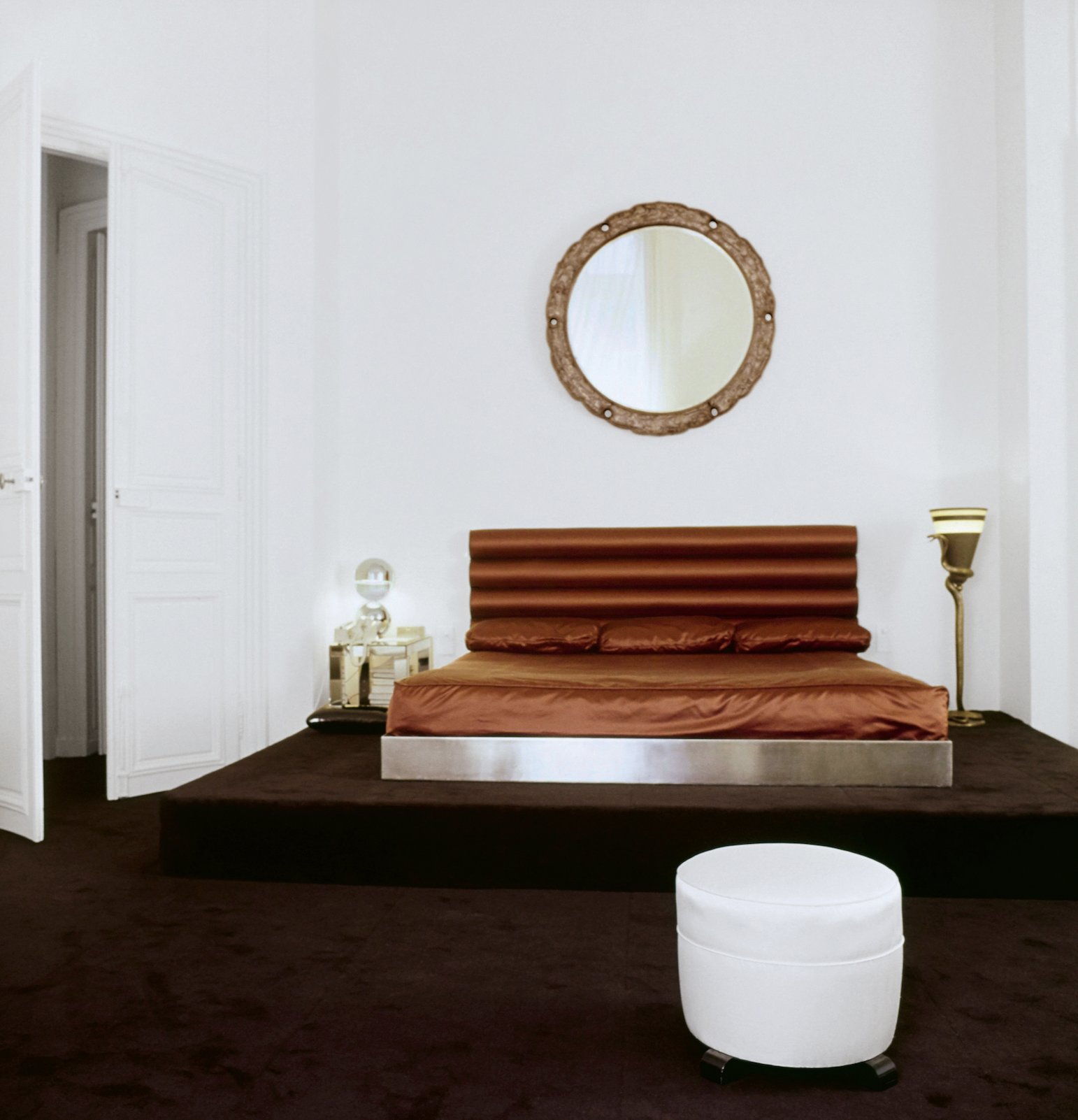
Lagerfeld died in 2019, and the process of dispersing his worldly goods is still ongoing. The Quái Voltaire apartment was sold this year for US$10.8 million (around $16.3 million). Now only the rue de Saint-Peres property remains within the Lagerfeld trust. Purchased after Quái Voltaire to further accommodate more of his books—35,000 were displayed in his studio alone, always stacked horizontally so he could read the titles without straining his neck—and as a place for food preparation as he loathed his primary living space having any trace of cooking smells. Today, the rue de Saint-Peres residence is open to the public as an arts performance space and most fittingly, a library.
You may also like.
By Josh Bozin
24/07/2024
Watch This Space: Mike Nouveau
Meet the game-changing horological influencers blazing a trail across social media—and doing things their own way.
In the thriving world of luxury watches, few people own a space that offers unfiltered digital amplification. And that’s precisely what makes the likes of Brynn Wallner, Teddy Baldassarre, Mike Nouveau and Justin Hast so compelling.
These thought-provoking digital crusaders are now paving the way for the story of watches to be told, and shown, in a new light. Speaking to thousands of followers on the daily—mainly via TikTok, Instagram and YouTube—these progressive commentators represent the new guard of watch pundits. And they’re swaying the opinions, and dollars, of the up-and-coming generations who now represent the target consumer of this booming sector.
—
MIKE NOUVEAU

Can we please see what’s on the wrist? That’s the question that catapulted Mike Nouveau into watch stardom, thanks to his penchant for highlighting incredibly rare timepieces across his TikTok account of more than 400,000 followers. When viewing Nouveau’s attention-grabbing video clips—usually shot in a New York City neighbourhood—it’s not uncommon to find him wrist-rolling some of the world’s rarest timepieces, like the million-dollar Cartier Cheich (a clip he posted in May).
But how did someone without any previous watch experience come to amass such a cult following, and in the process gain access to some of the world’s most coveted timepieces? Nouveau admits had been a collector for many years, but moved didn’t move into horology full-time until 2020, when he swapped his DJing career for one as a vintage watch specialist.
“I probably researched for a year before I even bought my first watch,” says Nouveau, alluding to his Rolex GMT Master “Pepsi” ref. 1675 from 1967, a lionised timepiece in the vintage cosmos. “I would see deals arise that I knew were very good, but they weren’t necessarily watches that I wanted to buy myself. I eventually started buying and selling, flipping just for fun because I knew how to spot a good deal.”
Nouveau claims that before launching his TikTok account in the wake of Covid-19, no one in the watch community knew he existed. “There really wasn’t much watch content, if any, on TikTok before I started posting, especially talking about vintage watches. There’s still not that many voices for vintage watches, period,” says Nouveau. “It just so happens that my audience probably skews younger, and I’d say there are just as many young people interested in vintage watches as there are in modern watches.”
View this post on Instagram
Nouveau recently posted a video to his TikTok account revealing that the average price of a watch purchased by Gen Z is now almost US$11,000 (around $16,500), with 41 percent of them coming into possession of a luxury watch in the past 12 months.
“Do as much independent research as you can [when buying],” he advises. “The more you do, the more informed you are and the less likely you are to make a mistake. And don’t bring modern watch expectations to the vintage world because it’s very different. People say, ‘buy the dealer’, but I don’t do that. I trust myself and myself only.”
—
Read more about the influencers shaking up horology here with Justin Hast, Brynn Wallner and Teddy Baldassare.
You may also like.
By Josh Bozin
24/07/2024
This Pristine 1960 Ferrari 250 Spider Could Fetch $24 Million at Auction
The car wears the same colours and has the same engine it left the factory with.
Some Ferraris are just a little bit more important than others.
Take, for example, the 1960 250 GT SWB California that RM Sotheby’s is auctioning off during this year’s Monterey Car Week. Any example of the open-top beauty would attract interest, but this one just so happens to be the first one that was built.
The 250 is one of the most legendary series of cars in Ferrari history. Between 1952 and 1964, the company released 21 different 250 models—seven for racetracks, 14 for public roads—of which the “Cali Spider” might be the most well regarded, thanks to its potent V-12 and a Pininfarina-penned design that is one of the most beautiful bodies to grace an automobile. The roadster, which was specifically built for the U.S., made its debut in 1957 as a long-wheel-base model (LWB), but it wasn’t until the SWB model debut in 1960 that it became clear how special it was. This example isn’t just the first to roll off the line. It’s the actual car that was used to introduce the world to the model at the 1960 Geneva Motor Show.
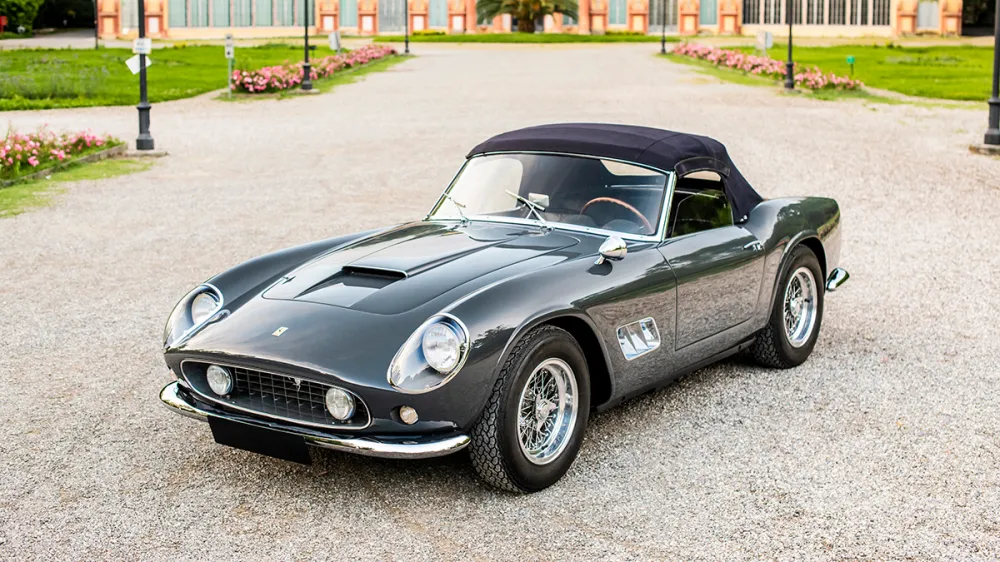
Just 56 examples of the 250 GT SWB California Spider would be built by Scaglietti during the three years it was in production. The first of those, chassis 1795 GT, is finished in a glossy coat of Grigio. The two-door had a red leather interior at Geneva but was returned to the factory and re-outfitted with black leather upholstery before being delivered to its original owner, British race car driver John Gordon Bennet. Six-and-a-half decades later the car looks identical to how it did when it left the factory the second time.
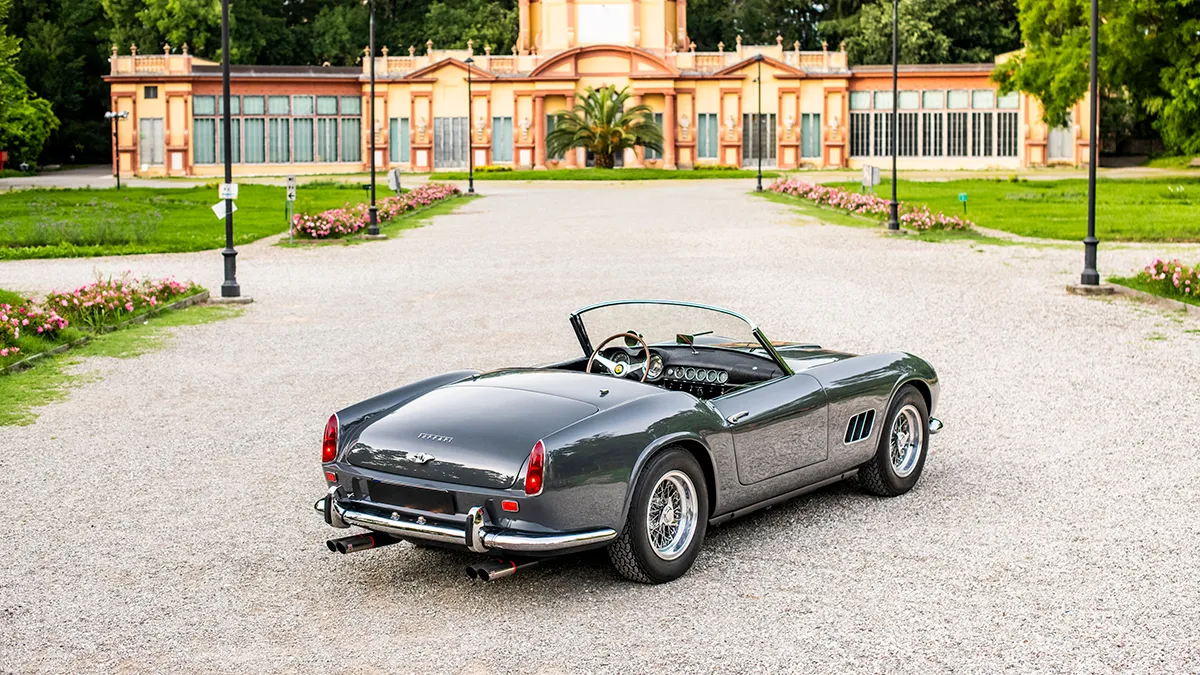
In addition to its original bodywork, the chassis 1795 GT features its original engine, gearbox, and rear axle. That mill is the competition-spec Tipo 168, a 3.0-litre V-12 that makes 196.1 kW. That may not sound like much by today’s standards, but, when you consider that the 250 GT SWB California Spider tips the scales around 952 kilograms, it’s more than enough.
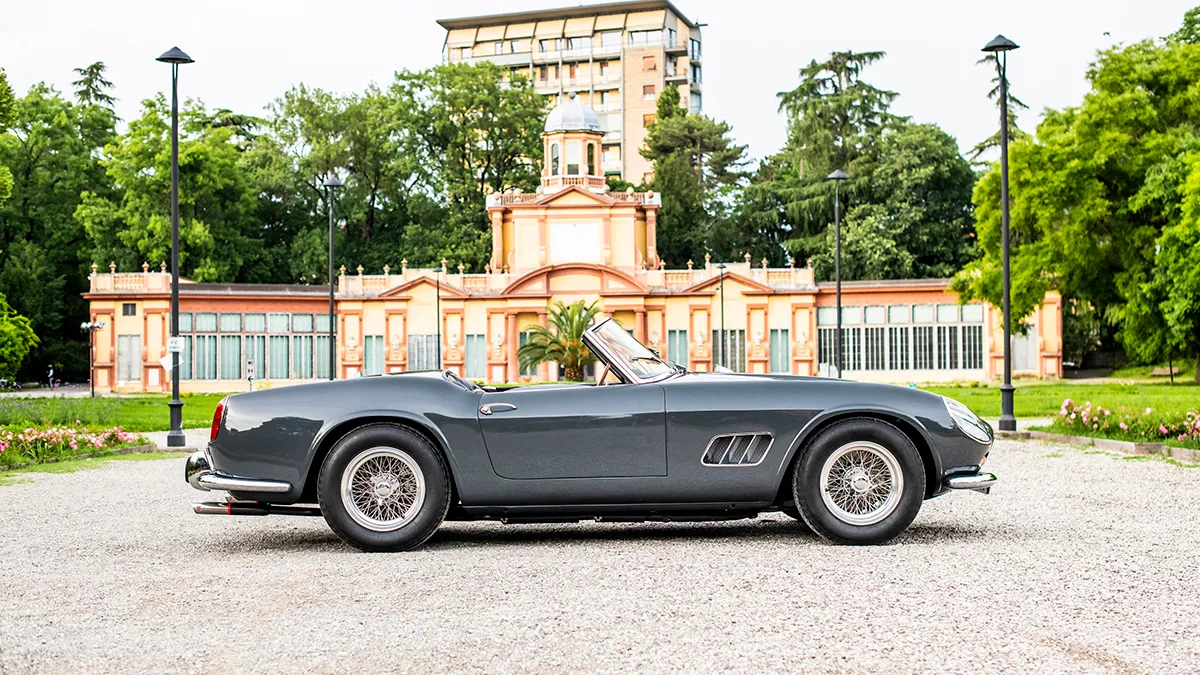
The first 250 GT SWB California Spider is scheduled to go up for bid during RM Sotheby’s annual Monterey Car Week auction, which runs from Thursday, August 15, to Saturday, August 17. Unsurprisingly, the house has quite high hopes for the car. The car carries an estimate of between $24 million and $26 million, which could make it one of the most expensive cars ever sold at auction.
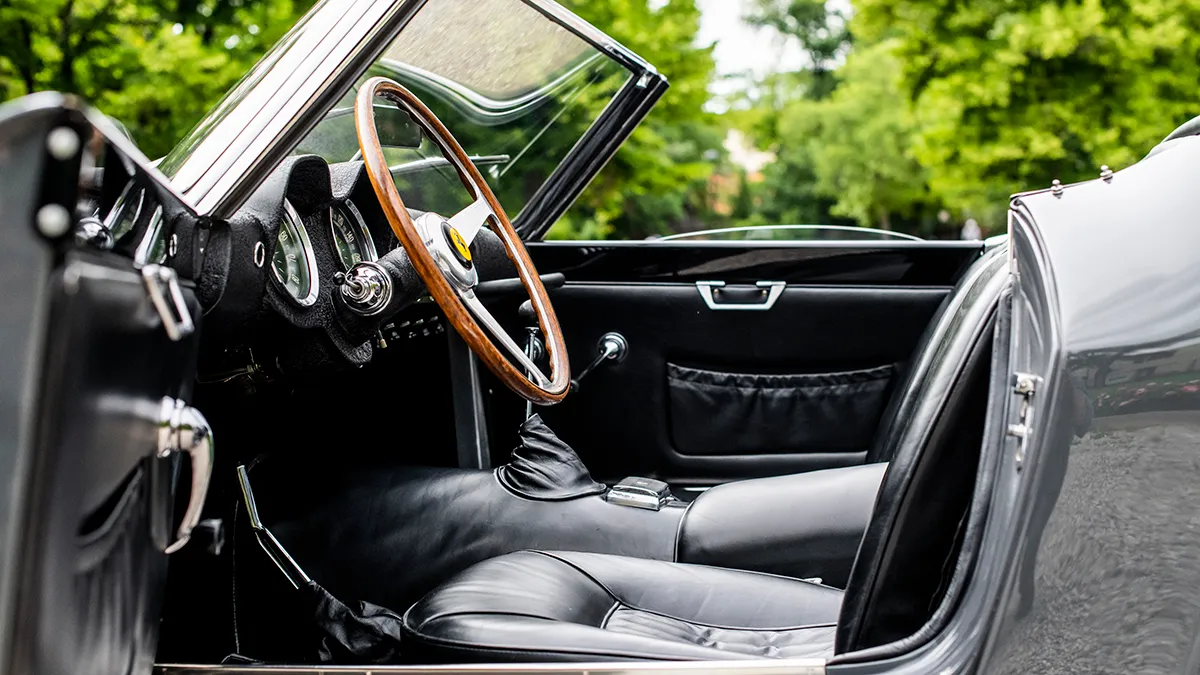
You may also like.
By Josh Bozin
24/07/2024






